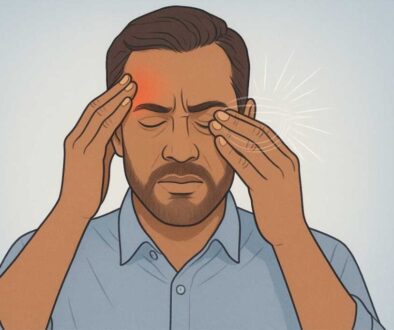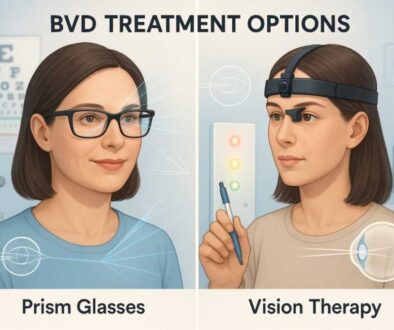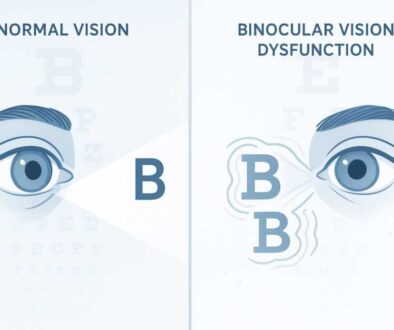BVD Symptoms in Children: When Reading Problems Signal Vision Issues
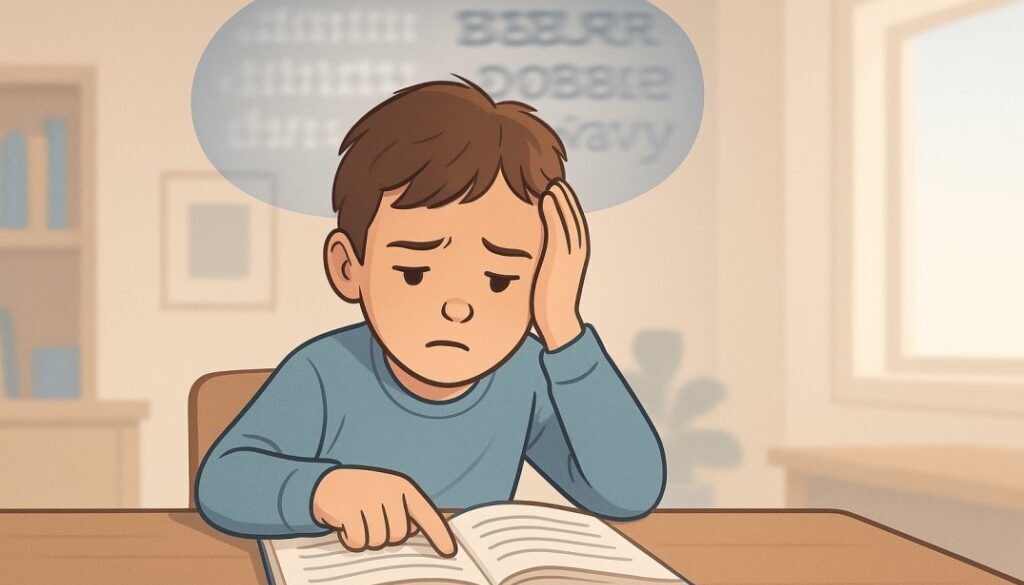
If your child struggles with reading despite normal intelligence and good teaching, the problem might not be learning-related—it could be their eyes. BVD symptoms affect up to 50% of children diagnosed with reading problems, ADHD, and learning disabilities, yet binocular vision dysfunction is rarely detected in standard school eye exams. This treatable condition causes subtle eye misalignment that creates devastating symptoms often mistaken for behavioral or learning issues.
Understanding Binocular Vision Dysfunction in Children
Binocular vision dysfunction occurs when a child’s eyes struggle to work together as a unified team. While standard vision screenings check how well each eye sees individually, they often miss the subtle misalignments that characterize this condition, a problem that may affect up to 50% of children diagnosed with ADD, ADHD, reading problems, and learning disabilities.
When eyes don’t align properly, each eye sends slightly different images to the brain. The brain struggles to merge these competing images into a single, clear picture, forcing the eye muscles to work overtime to compensate. This constant strain triggers a cascade of BVD symptoms that can devastate a child’s academic performance and quality of life.
The Hidden Crisis: Research from a landmark 1996 study published in the Journal of the American Optometric Association by Scheiman et al. revealed that binocular vision dysfunction and accommodative disorders are 9.7 times more prevalent than ocular disease in children six months to five years of age, and 8.5 times more prevalent in children six to eighteen years of age. Recent 2024 studies continue to confirm these high prevalence rates, with current data showing similar patterns globally. Despite this overwhelming prevalence, most parents, teachers, and even healthcare providers remain unaware of BVD symptoms and their connection to learning difficulties. Despite this overwhelming prevalence, most parents, teachers, and even healthcare providers remain unaware of this condition.
The Reading Connection: How Binocular Vision Dysfunction Destroys Academic Performance
Visual Chaos in the Classroom
Children with binocular vision dysfunction experience what specialists call “visual chaos”—a constantly shifting, unstable visual field that makes reading torture. Young patients often describe letters and words that “swim on the page,” “vibrate,” or “shimmer.” Imagine trying to read a book while someone gently shakes it—that’s the daily reality for children with untreated BVD symptoms.
The Academic Spiral
When reading becomes physically painful and exhausting, children naturally begin avoiding it. This avoidance creates a devastating spiral:
Immediate Effects:
- Decreased reading practice leads to falling behind grade level
- Homework takes significantly longer to complete
- Comprehension suffers due to visual strain and frequent re-reading
- Academic confidence plummets
Long-term Consequences:
- Teachers may label the child as “lazy” or “not applying themselves.”
- Self-esteem deteriorates as the child internalizes these labels
- Academic gaps widen, potentially leading to special education placement
- Social implications arise when the child can’t keep up with peers
Critical BVD Symptoms Every Parent Must Recognize
Reading-Specific Warning Signs
Visual BVD Symptoms During Reading:
- Losing their place on lines or pages frequently, requiring a finger or a bookmark to track
- Skipping lines while reading or trouble reading long strings of numbers
- Words appearing to run together or needing to be reread multiple times for comprehension
- Covering or closing one eye while reading
- Holding books unusually close or far from their face
- Complaining that words “move” or “dance” on the page
Visual BVD Symptoms During Reading:
- Losing their place on lines or pages frequently, requiring a finger or a bookmark to track
- Skipping lines while reading or trouble reading long strings of numbers
- Words appearing to run together or needing to be reread multiple times for comprehension
- Covering or closing one eye while reading
- Holding books unusually close or far from their face
- Complaining that words “move” or “dance” on the page
Physical BVD Symptoms:
- Headaches, especially after reading or focused vision tasks
- Blurry vision, dizziness, nausea, and stomach aches following visual tasks
- Excessive eye rubbing or blinking
- Watery eyes during reading
- Fatigue that seems disproportionate to the reading task
Behavioral Red Flags
Academic Behaviors:
- Poor handwriting with inconsistent spacing and letter sizing
- Avoiding homework or reading assignments
- Taking significantly longer than peers to complete visual tasks
- A preference for being read to rather than reading independently
- Strong verbal skills that don’t match written performance
Physical Behaviors:
- Appearing clumsy or uncoordinated, frequent tripping or bumping into objects
- Difficulty catching balls or poor hand-eye coordination
- Problems with stairs or depth perception
- Motion sickness in cars or other moving vehicles
Emotional and Social Behaviors:
- Unusually clingy behavior in large buildings with high ceilings, like malls
- Anxiety or overwhelm in crowded or visually complex environments
- Sudden behavioral changes coinciding with increased academic demands
- Emotional outbursts related to homework or reading
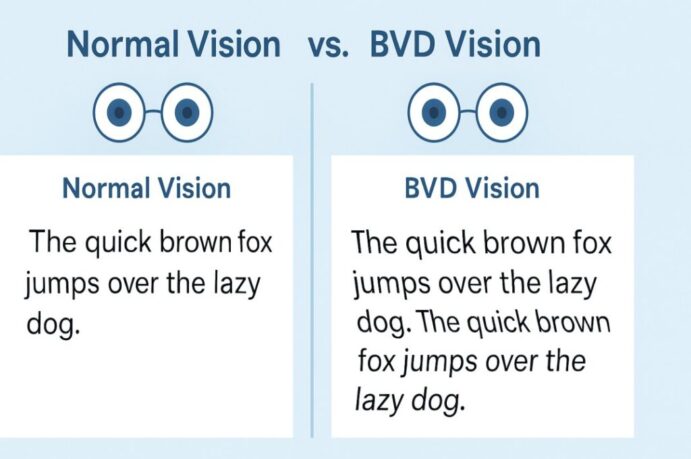
The Misdiagnosis Epidemic: Why Binocular Vision Dysfunction Gets Overlooked
ADHD vs. BVD Symptoms: The Dangerous Mix-Up
Poor concentration, anxiety, short attention span, and emotional outbursts are all BVD symptoms that overlap with ADHD, which is why children with binocular vision dysfunction are so frequently misdiagnosed. Research shows that children with ADHD are three times more likely to experience vision problems, such as binocular vision dysfunction.
The Overlapping BVD Symptoms:
- Difficulty maintaining focus during reading tasks
- Restlessness during “quiet” activities like homework
- Apparent inattention that’s visual discomfort
- Avoidant behaviors that seem like defiance
Why the Misdiagnosis Happens:
- Standard vision screenings don’t detect subtle misalignments that cause BVD symptoms
- Symptoms appear behavioral rather than visual
- Most healthcare providers lack awareness of binocular vision dysfunction
- Children can’t articulate their visual experiences
Learning Disabilities vs. Vision Problems
Dyslexia, reading comprehension difficulties, and learning disabilities all share similar symptoms with binocular vision dysfunction, including difficulty with concentration, reading, and comprehension. Over 50% of children who experience reading difficulties have been found to have some form of binocular vision dysfunction, a condition that is highly treatable when properly diagnosed.
Key Differentiators for BVD Symptoms:
- Children with binocular vision dysfunction often excel at verbal tasks while struggling with written work
- These children frequently compensate by becoming excellent auditory learners
- BVD symptoms worsen with increased visual demands (longer reading sessions, smaller print)
- Immediate improvement often occurs when one eye is covered
The Science Behind Binocular Vision Dysfunction: Latest Research Findings
Prevalence and Impact Studies
Current Research Findings:
- Recent studies show that approximately 25% of children experience some form of binocular vision disorder
- The 2024 BAND (Binocular Vision Anomalies and Normative Data) study found that non-strabismic binocular vision anomalies affected 30.6% of school children in both urban and rural populations.
- Convergence Insufficiency remains the most prevalent type, affecting approximately 1 in 12 children (8.3% of school-age children)
- Amblyopia affects 1.3% to 3.6% of children and remains the most common cause of monocular visual loss.s
Treatment Efficacy Research
Vision Therapy Success Rates: The landmark Convergence Insufficiency Treatment Trial (CITT) revealed that office-based vision therapy provides substantial improvements for children aged 9-17, with approximately 75% of participants experiencing resolution of symptoms within 12 weeks of treatment.
Recent follow-up studies from the CITT-ART (Attention and Reading Trial) confirm that significant improvements in convergence measures are maintained at one-year follow-up visits, demonstrating the long-term effectiveness of treatment.
Prism Lens Treatment: When subtle misalignments are treated with realigning prismatic lenses, the average patient reports an 80% reduction of symptoms.
Emerging Research on Digital Device Impact
Recent 2024 research shows concerning trends related to digital device usage and binocular vision in children. Studies demonstrate that binocular vision parameters like accommodative facility, accommodative amplitude, and positive fusional vergences are significantly reduced with increased exposure to digital devices.
Children who use digital devices for more than 3 hours per day show significantly higher rates of accommodative insufficiency, accommodative infacility, and fusional insufficiency compared to those with limited screen time. This finding has critical implications for modern children who spend increasing amounts of time on screens and suggests that digital device usage may be contributing to the rising prevalence of reading difficulties attributed to vision problems.
Treatment Options: Hope for Struggling Children
Specialized Prism Lenses
How They Work: Prismatic lenses work to correct misalignment by manipulating incoming light before it enters the eyes, so when images from both eyes reach the brain, the brain can fuse them into a single image.
Immediate Relief:
- Most children experience symptom reduction within days of wearing prescribed prism lenses.
- “I’m not tired when I read now. School is not as hard, and I have more fun. My glasses make everything better.” – Justin, patient testimonial.
- “The headaches disappeared. Reading was so much easier, and I could figure out my homework.” – Kali, patient testimonial.
Vision Therapy Programs
Comprehensive Approach: Vision therapy exercises, such as vectograms and Brock String activities, strengthen binocular coordination and target eye teaming and visual-motor integration.
Evidence-Based Results: Studies published in multiple peer-reviewed journals, including The Journal of Behavioral Optometry and recent 2024 research from Insight Vision Center Optometry, show that structured therapy focusing on eye coordination yields significant improvements in spatial awareness and physical stability in children.
The Importance of Specialized Testing
Beyond Standard Eye Exams: Standard school vision screenings test visual acuity (how well each eye sees) and major eye misalignment, but they don’t test for small amounts of misalignment that characterize BVD.
NeuroVisual Evaluation: For over 20 years, thousands have been helped by the NeuroVisual Evaluation—a specialized eye exam that finds subtle vision misalignment missed by routine screenings.
Real-World Case Studies: Transformation Stories
Case Study 1: Seven-Year-Old RuthAnn
RuthAnn was having difficulty reading and paying attention in school. When she visited Vision Specialists of Michigan, she was diagnosed with Binocular Vision Dysfunction and received help from NeuroVisual Specialists. Her transformation illustrates the dramatic improvement possible when BVD is properly identified and treated.
Case Study 2: The Academic Turnaround
“I was about to be put into a special education class because I was having so many learning problems. That was 10 years ago. These lenses changed everything! The headaches disappeared. Reading was so much easier, and I could figure out my homework.” – Kali’s testimonial demonstrates the life-changing potential of proper BVD treatment.
Case Study 3: Lucy and Jen from Huntington
Lucy and Jen, two outgoing 4th graders, came for evaluation after having difficulties with reading and paying attention in class. After a thorough developmental eye exam, both were diagnosed with convergence insufficiency and began vision therapy.
When to Seek Professional Help
Red Flag Combinations
Seek immediate evaluation if your child exhibits:
- Reading struggles combined with headaches
- Good verbal skills but poor written performance
- Behavioral issues that worsen with homework
- Physical symptoms (nausea, dizziness) during reading
- Avoidance of visually demanding tasks
Finding the Right Provider
Critical Qualifications:
- Experience in binocular vision dysfunction diagnosis
- Access to specialized testing equipment beyond standard eye charts
- Training in NeuroVisual Medicine or developmental optometry
- Ability to prescribe prism lenses and oversee vision therapy
Questions to Ask:
- Do you test for subtle eye misalignments?
- What percentage of your practice involves BVD?
- Do you offer NeuroVisual Evaluations?
- Can you prescribe micro-prism lenses?
The Path Forward: Early Intervention Saves Futures
Why Time Matters
Recognizing and addressing BVD in children is critical for ensuring their visual development and overall quality of life. The earlier BVD is identified and treated, the less academic and emotional damage occurs.
Critical Windows:
- Ages 4-8: Foundation years when reading skills develop
- Ages 9-13: Academic demands intensify, symptoms often worsen
- Ages 14+: Self-esteem and academic confidence become increasingly important
Prevention of Long-term Consequences
Academic Protection:
- Prevents unnecessary special education placement
- Maintains grade-level performance
- Preserves love of learning and reading
Emotional Safeguarding:
- Protects self-esteem and confidence
- Prevents the development of anxiety around academic tasks
- Maintains positive school relationships
Physical Well-being:
- Eliminates chronic headaches and eye strain
- Improves overall quality of life
- Enables full participation in sports and activities
Conclusion: Your Child’s Future Depends on Recognition
The reality is stark but hopeful: Millions of children suffer needlessly from BVD symptoms that destroy their academic potential and self-esteem, yet this condition is highly treatable when properly diagnosed.
FAQs
-
BVD is a vision problem where the eyes are slightly misaligned, making it hard for the brain to combine images, often causing reading and learning difficulties
Please note: None of the above should be considered medical advice. If you’re having any concerns about your vision, please reach out to us immediately or see your primary care provider.

